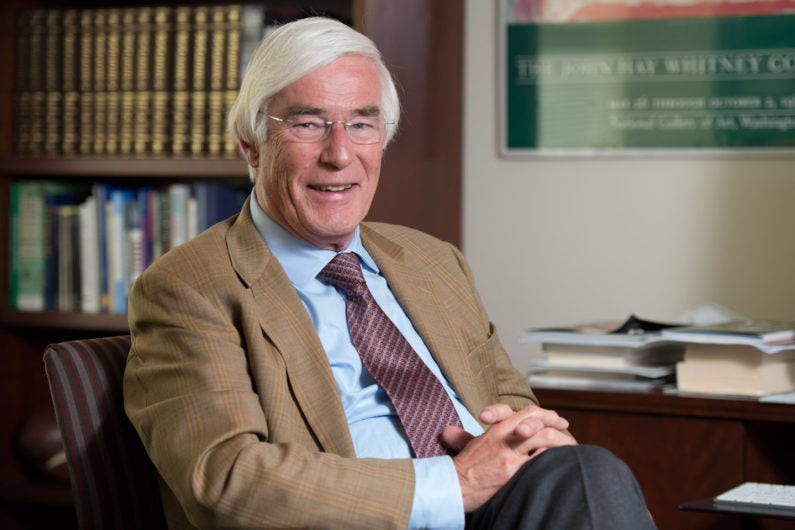Stanford to rename Manzanita Park residence to honor Gerhard Casper’s lasting legacy
The Gerhard Casper Quad includes the Humanities House and three other undergraduate dorms. It also features a dining commons, an outdoor green space and an organic garden focused on teaching sustainable food production.
Stanford will rename Manzanita Park, an undergraduate residential complex on the east side of campus, in honor of Gerhard Casper, who spearheaded the university’s renaissance in undergraduate education during his tenure as president from 1992 to 2000.
As Stanford’s ninth president, Casper oversaw an extensive review of undergraduate education that led to major initiatives designed to improve the student experience, including Introductory Seminars for freshmen and sophomores. In 2000, Casper’s successor, John L. Hennessy, launched the Campaign for Undergraduate Education to establish permanent funding for the initiatives.

Gerhard Casper (Image credit: L.A. Cicero)
“The Stanford undergraduate experience would not be what it is today were it not for Gerhard Casper’s leadership,” Hennessy said. “The landmark enhancements – from small group experiences led by senior faculty, to undergraduate research opportunities, to living-and-learning residential experiences – transformed undergraduate education at Stanford, and naming these undergraduate residences the Gerhard Casper Quad seemed fitting recognition for the lasting impact he has had.”
Stanford will hold a private dedication ceremony for the Gerhard Casper Quad and Gerhard Casper Dining Commons on Tuesday morning, May 31, at the residential complex, located on Escondido Road. The speakers will be Steven A. Denning, chair of the Stanford University Board of Trustees; Stanford President John L. Hennessy; and Gerhard Casper.
Casper, who became president of the American Academy in Berlin in 2015, is a senior fellow at the Freeman Spogli Institute for International Studies (FSI) and at the Stanford Institute for Economic Policy Research. Casper served as FSI’s director from 2012-2103. He also is an emeritus professor of law at Stanford and the Peter and Helen Bing Professor in Undergraduate Education, emeritus.
Gerhard Casper Quad comprises four residence halls, including the Humanities House, which opened in 2015. The complex includes the Gerhard Casper Dining Commons, an outdoor green space, and an organic garden focused on teaching sustainable food production. The three other residences are Kimball Hall, which opened in 1991, and Castaño Hall and Lantana Hall, which opened in 1992. Today, the complex houses approximately 550 students.
Casper, who was born in Hamburg, Germany, studied law at the universities of Freiburg and Hamburg, where he earned his first law degree in 1961. After earning a master of laws degree from Yale University in 1962, he returned to the University of Freiburg, where he earned a PhD in 1964. That same year he immigrated to the United States and began teaching political science at the University of California, Berkeley. Two years later, he joined the faculty of the University of Chicago, where he served as the provost of the university, the dean of the law school, and as a professor of law during his 26-year tenure.
Casper has written and taught primarily in the fields of constitutional law, constitutional history, comparative law and jurisprudence. In addition to books on legal realism, the U.S. Supreme Court, and other subjects, he wrote Separating Power, which examines the separation of powers practices in the last quarter of the 18th century in the United States. He also wrote about his experience serving as Stanford’s president in Cares of the University and in The Winds of Freedom: Addressing Challenges to the University, published in 2014. Casper discussed The Winds of Freedom in this Stanford video.
After stepping down as Stanford’s president in 2000, Casper taught freshmen in their first quarter of the Introduction to the Humanities program. He also taught in Sophomore College and at the Law School.
Casper headed the executive committee of the Stanford Arts Initiative, which was part of The Stanford Challenge, a five-year fundraising campaign that raised $6.2 billion to seek solutions to global problems and educate leaders for a more complex world. The arts initiative led to an unprecedented expansion of arts facilities on campus, including the opening of Bing Concert Hall, the Anderson Collection at Stanford University, and the McMurtry Building for the Department of Art & Art History. The initiative also created new faculty positions, graduate student fellowships and student programs.
